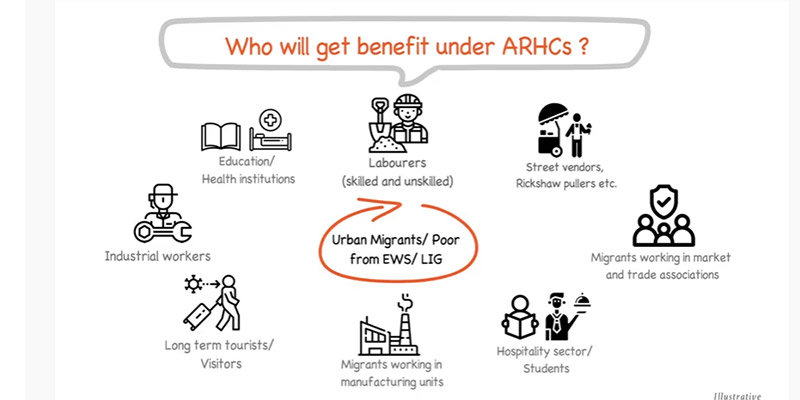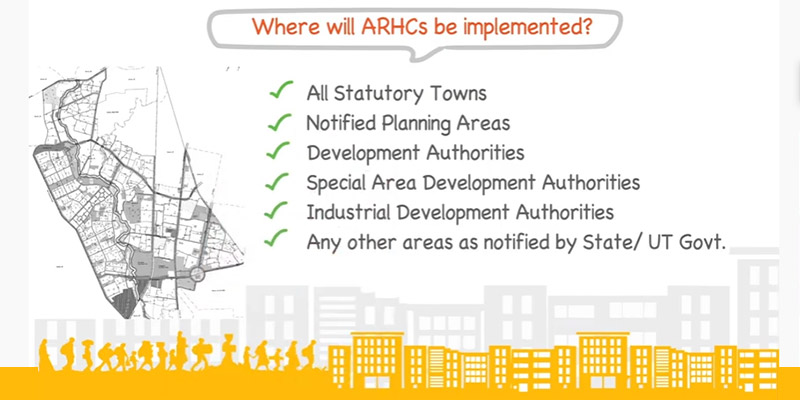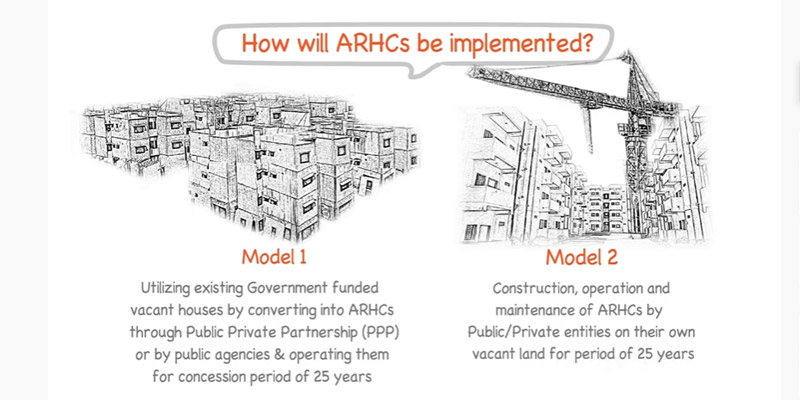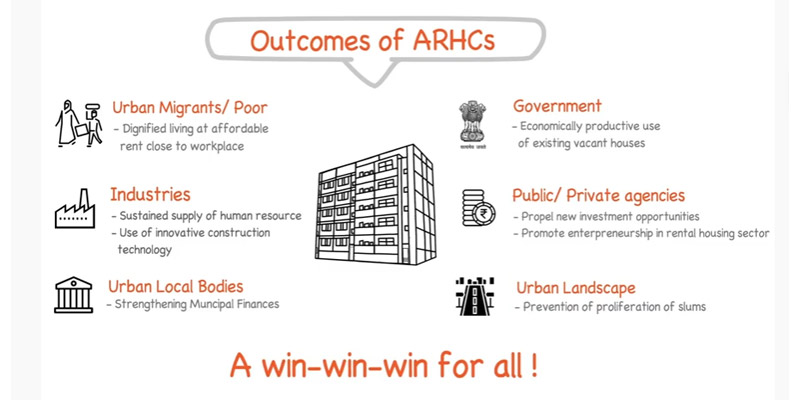What is The Significance Of The Affordable Rental Housing Complexes Scheme?
- 19th Oct 2021
- 1972
- 0

Never miss any update
Join our WhatsApp Channel
A large proportion of urban migrants live in slums, informal settlements and unauthorized colonies, in order to save rental costs. They spend a substantial time commuting to their workplaces either by walking or cycling to reduce the travel expenses. Hence, to improve their productivity and to offer them ease of living, the Government of India felt the need of promoting rental housing for them to achieve inclusive urban development.
As a result, the Ministry of Housing & Urban Affairs, Government of India, has initiated Affordable Rental Housing Complexes (ARHCs), a sub-scheme under the Pradhan Mantri Awas Yojana - Urban (PMAY-U). The main objective of the scheme is to offer ease of living and provide access to dignified / planned housing to urban poor, close to their workplaces in the industrial sector as well as in the non-formal urban economy.
When was the scheme announced?
The scheme, which was announced in May 2020 as a part of the broader economic stimulus package, was recently approved by the Union Cabinet on 8th July 2020. The scheme is seen as a vital step towards the vision of ‘AtmaNirbhar Bharat Abhiyan’. Furthermore, this would give an impetus to the broader objective of “Housing for All”.
Who are the target beneficiaries under the ARHC scheme?
The ARHC scheme is initially expected to benefit nearly 3 lakh people, especially the urban poor and migrants, from EWS and LIG categories, who come to urban areas in search of better employment opportunities from villages and small towns.
This would broadly include labour, street vendors, rickshaw pullers and other service providers, and a major part of workforce employed in industrial, manufacturing, hospitality and health care sectors, along with those working in commercial establishments. Long term tourists, visitors, students, etc. would also get covered under the scheme.
Strives to build a new ecosystem for urban poor and migrants
As per the operational guidelines of the scheme, an ARHC is a listed project with a mix of at least 40 dwelling units and dormitories along with basic civic infrastructure facilities such as water, sanitation, sewerage / septage, road, electricity along with necessary social / commercial infrastructure for urban migrant / poor of economically weaker sections (EWS) / low income group (LIG) categories.
As a significant pro-poor measure, the government, under this scheme, intends to formulate a sustainable ecosystem wherein workers would get rented accommodations at affordable rates, which would enhance their quality of life and also minimize unnecessary work related travel. This would also inculcate in them a sense of security and encourage them not to migrate to their home towns in a crisis situation such as COVID-19.
Implementation Models of ARHCs

The government would implement the scheme across all statutory towns, notified planning areas, development authorities, special area development authorities, industrial development authorities and any other area as notified by State / UT Government. All projects under ARHCs shall be exclusively utilized for rental housing for a minimum period of 25 years.
The government has outlined two models for implementing ARHCs which are explained below:
1) Model 1 - Converting the existing government funded vacant houses into ARHCs through public private partnership (PPP) or by public agencies.
Currently, there are nearly 1.2 lakh completed, non-allotted and government funded housing units across cities, under various former and existing housing schemes such as the Jawaharlal Nehru National Urban Renewal Mission (JNNURM), Rajiv Awas Yojana (RAY), PMAY-U and other state-run housing schemes.
Completed units under such schemes would be converted into rental housing complexes. The government would emphasize on conversion through concession agreements for a period of 25 years, and states / union territories would select the concessionaires via transparent bidding.
The selected concessionaires would be responsible for making these complexes liveable by undertaking repair / retrofitting works, maintenance of buildings, and fixing infrastructure concerns related to water, sewer, sanitation, road, etc.
The concessionaires would also ensure development of essential social infrastructure and commercial facilities, including health centres, community centres, shops, grocery store, medical shops, ATMs, etc.
Upon completion of 25 years, these housing complexes would be transferred to Urban Local Bodies which would restart the next cycle, either in the same way or on their own.
2) Model 2 - Construction, operation and maintenance of ARHCs by public / private entities on their own available vacant land.
Under this model, the government would encourage private and public entities to develop ARHCs on their own available unused land, by offering special incentives and benefits. Many industries, trade associations, manufacturing companies, educational & health institutions, development authorities, public sector undertakings, etc. have a large portion of unutilized vacant land.
These entities would themselves construct, operate and maintain ARHCs on their vacant land for 25 years. They may use ARHCs to provide accommodation to their own workers/ labours as well as serve the requirement of neighbouring entities.
A slew of incentives to promote development of such housing complexes would include concessional project financing, income tax & GST exemptions on any profit and gains from ARHCs, technology innovation grant (TIG) for use of innovative technology, use permission changes, 50% additional Floor Area Ratio (FAR) or Floor Space Index (FSI) free of cost, single window clearance (30 days), concessional loan at priority sector lending rates and tax reliefs at par with affordable housing, among others.
The government is considering an initial estimated expenditure of INR 600 crore in the form of technology innovation grant, to be released for projects using identified innovative technologies for construction.
| Various Housing Schemes by Govt of India |
| PMAY |
| PMAY-G |
| PMAY Urban |
What are the expected benefits of ARHCs?

Successful implementation of ARHCs would provide ease of living to migrant workers and urban poor, and would certainly uplift their lifestyle.
They would get decent accommodation in urban areas at affordable rent. More importantly, these complexes would be close to their workplaces.
It intends to empower the EWS and LIG segments, giving them sense of security and in a way preparing the unprivileged section of the society for the new normal.
This would also ensure sustained supply of human resource for industries and manufacturing units etc.
The scheme would enable productive utilisation of already completed government funded houses which are currently lying vacant.
ARHCs are expected to propel new investment and drive future job creation in the rental housing sector. The scheme incentivizes private and public players to develop ARHCs on their own vacant land.
Moreover, this would prevent future growth of unplanned slums in the country.

 Admin
Admin



Comments
No comments yet.
Add Your Comment
Thank you, for commenting !!
Your comment is under moderation...
Keep reading blogs